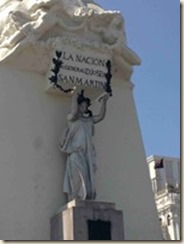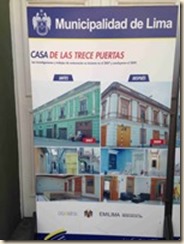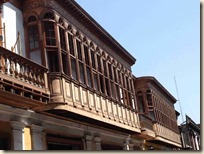One sea day later and we are arriving in Callao, the port stop for Lima. We’ve joined another Rosie (Cruise Critic) tour and we all meet at the appointed time in the photo gallery. We’re docked today, but we can’t walk out of the port – we must use their shuttle buses. So, we all troop out to the bus and hop aboard. The ride through the port is long – we wind around and eventually get out of the commercial area, but then the bus takes us to the main square in Punto – a small town adjacent to the port. Not where we were supposed to be dropped – and not where our tour guide is meeting us. Oops.
Rosie has it handled though – she calls the tour operator and after some twisted explanations (the tour guys can’t figure out why we are in this particular square when they were told we’d be elsewhere), we are assured our guide is coming.
After about 5 minutes, Jose shows up and our van awaits. We have a slightly bigger group today, but the van is bigger as well, so we still have room to spread out and listen to Jose as we start our hour long drive into Lima. His recounting of the history of the area if very interesting (I remember nothing of this from the time we were here between the Galapagos and Machu Picchu). Lima is the 2nd driest capital city in the world (Cairo is #1), there is virtually no rain. And the streets reflect this – there is no drainage built into any of the streets or houses. There is no subway and no skyscrapers because of the earthquakes (which happen just about every day – a fact not reported by the media, because they happen so frequently – and lamented by Jose when he comments that the earthquake in Japan was just reported, but never the Peruvian earthquakes).
We get the overview of the taxes (lots – 22% flat tax, 18% sales tax); the poor wages, and that, while the city started out differently, most of the people here are no longer Catholic. Only only 25% are now Catholic, having something to do with an extra 5% tax to be Catholic? He talks a lot about heritage and Inca philosophy that says nothing is for free, support each other with respect, but don’t give out money or services for nothing – there must be a two way exchange.
Our first stop is the main square of Lima, which is lined with beautiful white colonial era buildings and centered around a statue of San Martin, the general who fought to win the city. We learn the square and the buildings were built as a display of pride and affluence to impress foreign dignitaries. There is also a great story about the statue itself.
The President who commissioned it wanted a statue of Liberty (similar to the Liberty statue created for the US). But the sculptor, instead created the statue representing a more Roman Liberty figure. In addition, the President told the sculptor he wanted a flame (just like the US statue). However the President spoke Castilian Spanish, not traditional Spanish and the sculptor didn’t understand him. The word for flame in Castilian is jama, thus the sculptor thought the President said “Llama.” If you look closely at the picture below, you can see the llama on the top of Liberty’s head.
 The architecture is very European, by design, because the founders of the city wanted it to be more European than colonial (so my Colonial comment above isn’t exactly accurate). The buildings do remind you of many large European cities, except for the fact that 90% of downtown Lima buildings are empty. The Government owns most of the buildings, purchased (or appropriated) after the affluent left the area during the years of the Shining Path terrorism era. You can see that here in the square, where the upper rooms of the buildings are empty, but the bottom floors are being used for retail.
The architecture is very European, by design, because the founders of the city wanted it to be more European than colonial (so my Colonial comment above isn’t exactly accurate). The buildings do remind you of many large European cities, except for the fact that 90% of downtown Lima buildings are empty. The Government owns most of the buildings, purchased (or appropriated) after the affluent left the area during the years of the Shining Path terrorism era. You can see that here in the square, where the upper rooms of the buildings are empty, but the bottom floors are being used for retail.
The one exception is the hotel on the corner (where we stop for a restroom break in bathrooms covered in copper and marble). It is opulent and beautiful, with a stained glass dome for the lobby ceiling and long high ceilinged hallways with polished woodwork. A stark difference to the rest of the stores and buildings around the square.
After exchanging some money, we hop back in the van for our next stop at the Cathedral and catacombs. But first, Jose takes us to one of the old mansions of the city. Most of these opulent buildings were owned by the rich. Buildings spanned entire blocks and the streets were actually named for the richest person on the block. Now, the buildings have been split up into different units, which you can see from this block – the great old European balcony area, and then the separate (different colored) buildings that used to be one residence, now separated.
We get to take a look inside this particular residence, as it has been turned into a hostel. With a lot of the original architecture and artwork still intact. There is a domed skylight of ornamental glass, roman style busts and oil paintings all over the place. Plus beautiful original wood chairs and benches. Pretty amazing
We walk around the block to the cathedral – where we learn that most of the city inhabitants were Jesuits – not because they particularly believed in that sect of religion – but because the Jesuits had the first printed bible. This was such a huge deal, that people joined the church just to get the bible.
The church itself is a combination of European and Moroccan influences. Lots of gold and archways with bold Moroccan patterns.
We get the whole tour of the library where the printed bible is stored – plus thousands of other old books – really neat, but sadly no photos allowed. Then down to the catacomb, where thousands of bones are stored and arranged in neat little sections. We see how they constructed the church in such a way that it withstands the earthquakes (thankfully, since we are underneath the darn thing in the catacombs and I was really fine with the close space until this discussion – let’s not hyperventilate now).
Finally out into the fresh air (phew), we walk to an archeology museum with an outdoor dig representation, then past a bunch of government propaganda signs showing the restorations being done throughout the city.
Then we head through a little pedestrian area where Jose buys us quinoa and honey balls (really nice little snack which I’m going to try to figure out how to replicate at home)…
…then onto the oldest bar in Lima, which we get paraded through, looking like the tourists we are, and getting relatively unfriendly stares from the local constituents (which we deserved, disturbing their otherwise peaceful setting).

We are let loose for 20 minutes to shop at a local artisan market, go to the chocolate museum or head back to the bar for a cerveza. We decide to spend our time in the chocolate museum, where we have some lovely chocolate tea and then end up buying 5 little chocolate squares of different flavors.
Back at the store, we corral everyone and walk around the corner to watch the changing of the guards at the Presidential Palace. It is quite a spectacle, and goes on every day with the marching bands and soldiers. There is quite a crowd as well, so pictures aren’t exactly great, but it is fun to take in the pomp and circumstance.
After about 5 minutes, though, we’re all getting restless in the hot sun, so we tour the rest of the square with the picturesque cathedral, museum and other government buildings. It is truly a gorgeous city – inhabited or not, as the case may be.




































No comments:
Post a Comment